Various species of purple bugs live around the world. From beetles to spiders, purple is one of the most intriguing colors in the animal kingdom, mainly due to its scarcity.
Purple color can be natural to bugs regardless of their environment. It can also be a purposeful appearance change in species such as spiders which may take on purple coloring when hunting purple flowers.
Purple bugs are often found in North America, particularly in the Southern and Eastern states.
They live in areas with sufficient vegetation which is used for food and shelter. Some have even adapted to living in areas with no vegetation or low vegetation such as on dunes.
Purple bugs may also migrate for overwintering or whenever their food resources start to run out.
Here are some of the most common purple bugs on the continent which may be spotted individually as solitary species or in groups.
1. Nuttall’s Blister Beetle
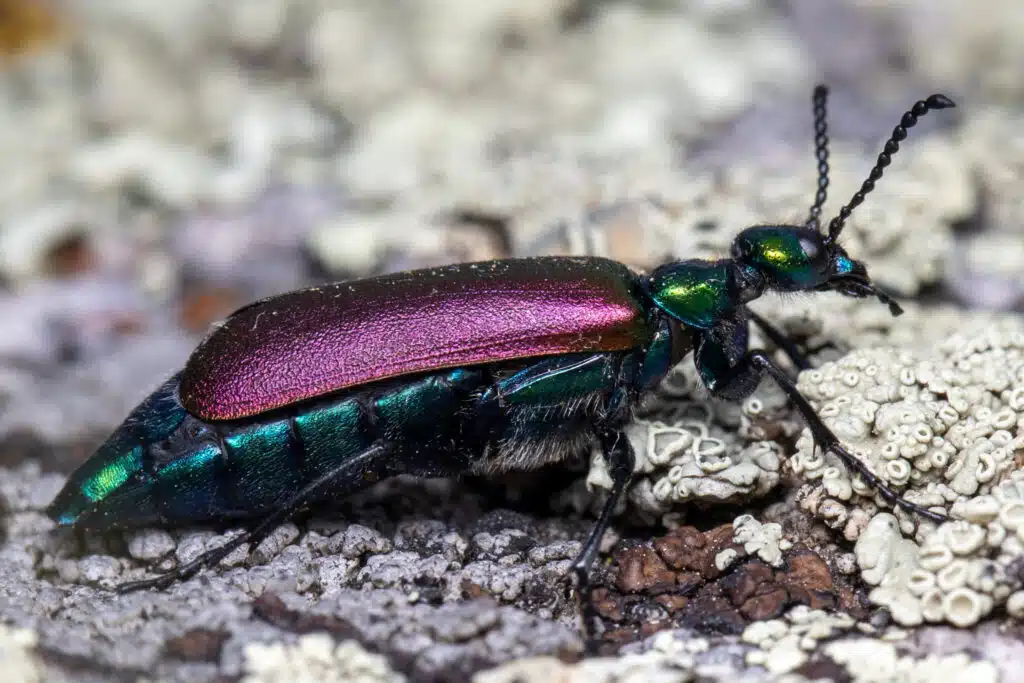
Often found on prairies, Nuttall’s Blister Beetles (Lytta nuttalli) are among the purple species which contrast their natural habitat.
While many types of prairie bugs are green or match their habitat, Nuttall’s Blister Beetles have a purple or purple-green color.
This purple nuance is specific to its upper exoskeleton while the body has a metallic green or green-blue nuance.
The amount of purple coloring on the species can differ from one individual to another.
Some have purple shades on the sides of the body while others are almost completely purple when seen from above.
Found in Southern US states, this type of beetle has a presence in New Mexico and Arizona.
The exact purple nuance and the amount of purple exoskeleton coloring differs from one individual to another and from one subspecies to another.
Living solitary lives, these types of beetles mostly nest in the ground in bee nests.
2. Notch-mouthed Ground Beetle
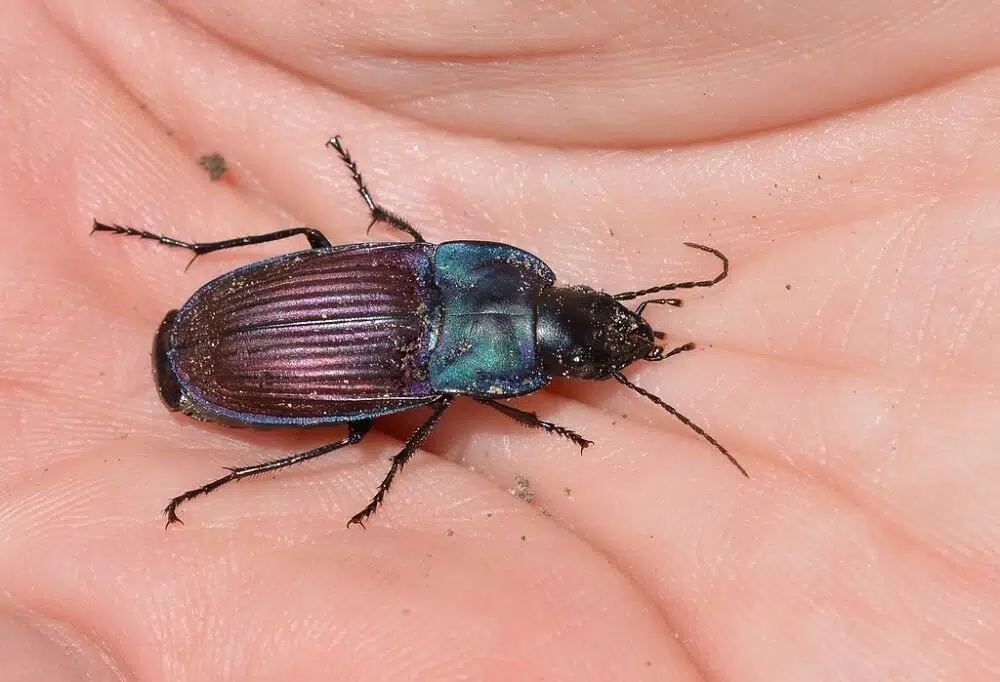
Varying colors are specific to The North-mounted Ground Beetle (Dicaelus purpuratus).
This ground dweller is often purple or blue and purple with a shiny exoskeleton.
Other colorful morphs of the species include a blue or blue and black morph also seen in woodlands.
As it lives in woodlands, this species may rely on its colorful nuance to escape predators.
Still, Noth-mounted Ground Beetles are nocturnal and face a lower number of predators compared to many other beetles.
Moving through vegetation and leaves on the ground, this is a species that lives in a vast habitat of woodlands, mainly in the Eastern parts of North America.
The Notch-mounted Ground Beetle impresses with its capacity to look for food and trap insects as large as itself using its large jaws.
This bug can sometimes be spotted under rocks and logs during the day.
3. Purple Tiger Beetle

Purple Tiger Beetles (Cicindela purpurea) also live in woodlands, similar to Notch-mounted Ground Beetles.
Unlike other species, these beetles prefer clearing in woodlands as they rely on their vision to locate prey.
Purple Tiger Beetles are mainly purple, but they can also be completely green or only partly purple.
The purple color of the species has a dark nuance, similar to its green morph.
Purple dominates the exoskeleton of the species but it is often contrasted by white or cream bands on the lower parts of the body.
There are 5 subspecies recognized for this beetle, all of them sharing the same habitat.
Some of the best areas to see these bugs include pathways or trails along woodlands as they often live in vegetated areas in search of food.
4. Florida Purplewing
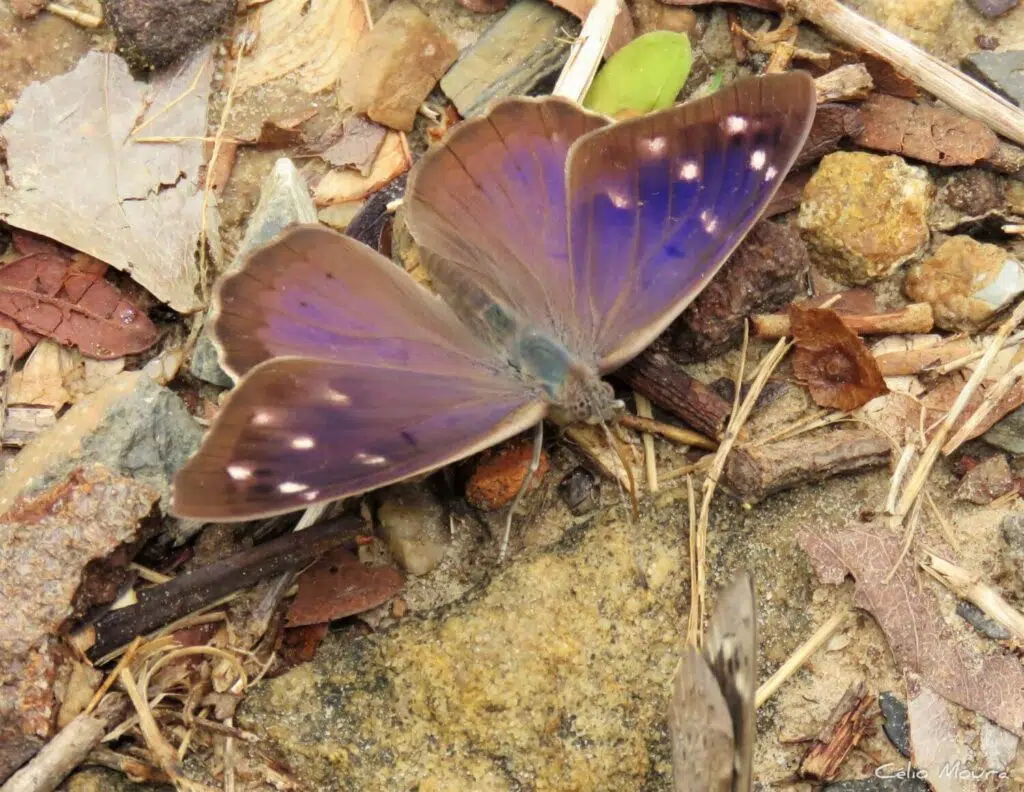
As its name suggests, the Florida Purplwing (Eunica tatila) is native to Florida. This species is also confirmed in Southern US states and further South into The West Indies.
The Florida Purplewing is among the species with deep purple or purple-blue wings.
This vivid color is only specific to the inner parts of its wings, closer to the body. Its outer wings are mostly black.
Both the purple and the black sections of its dorsal wings show white spots as well.
The ventral wings of The Florida Purplewing are mostly dark brown and light brown, mimicking tree bark coloring.
Florida Purplewing is among the species that can feed on fruit.
This species is often seen in areas with plenty of wildflowers and plants such as yellow, pink, or orange lantanas.
5. Pavon Emperor

Southern Texas and Mexico mark the range of the purple Pavon Emperor (Doxocopa pavon).
This is a species that is mostly associated with host trees such as those in the hackberry genus.
The wings of this species are marked by a large purple area. Most upper and hindwings are purple.
Brown margins are specific to the dark purple wings of The Pavon Emperor.
This is also a species that has a brown body and orange margins on its upper forewings.
White spots are also seen on its wings.
However, it’s only the male Pavon Emperors that have purple wings as females have dark brown and white wings.
Both males and females are seen as small butterflies in their native range. The wingspan of the species typically measures anywhere between 2 and 3 inches.
Some of the best sights to spot purple male Pavon Emperors are in full sun. Males open up their purple wings and showcase their upper wings as a means to attract females.
They always position themselves in full sun where their colorful wings are easier to spot.
6. Purple Crow Butterfly

Purple Crow Butterflies (Euploea tulliolus) are brown but they show their purple upper forewings’ iridescence under direct sunlight.
The species impresses with its purple appearance only on its forewings as its hindwings are mainly lighter brown or gradient brown, lighter towards the margins.
Native to regions of Asia, this type of butterfly is best seen in the summer when it begins its yearly migration in large numbers.
The species lives in large numbers through the summer, reaching an average wingspan of 3-4 inches.
Some of the largest migration areas of this species include routes in Taiwan.
Purple Crow Butterflies are now growing in numbers in Oceania as well. They may or may not migrate to their new territories such as those across Australia.
Further Reading:
7. Southern Purple Mint Moth

Southern Purple Mint Moths (Pyrausta laticlavia) are found in Southern and Southwestern US territories.
Its wings show a contrasting yellow and purple color, making the moth stand out on its host plants.
The purple nuance is mostly specific to the margins of its wings.
Southern Purple Mint Moths are always found close to rosemary, as this is the atypical host plant of its caterpillar.
Southern Purple Mint Moths are regarded as small to medium-sized species.
Even the largest moths of this family may only reach a maximum wingspan of 0.6 inches.
These types of moths are mostly spotted in the summer, up to the end of August.
8. Elephant Hawkmoth
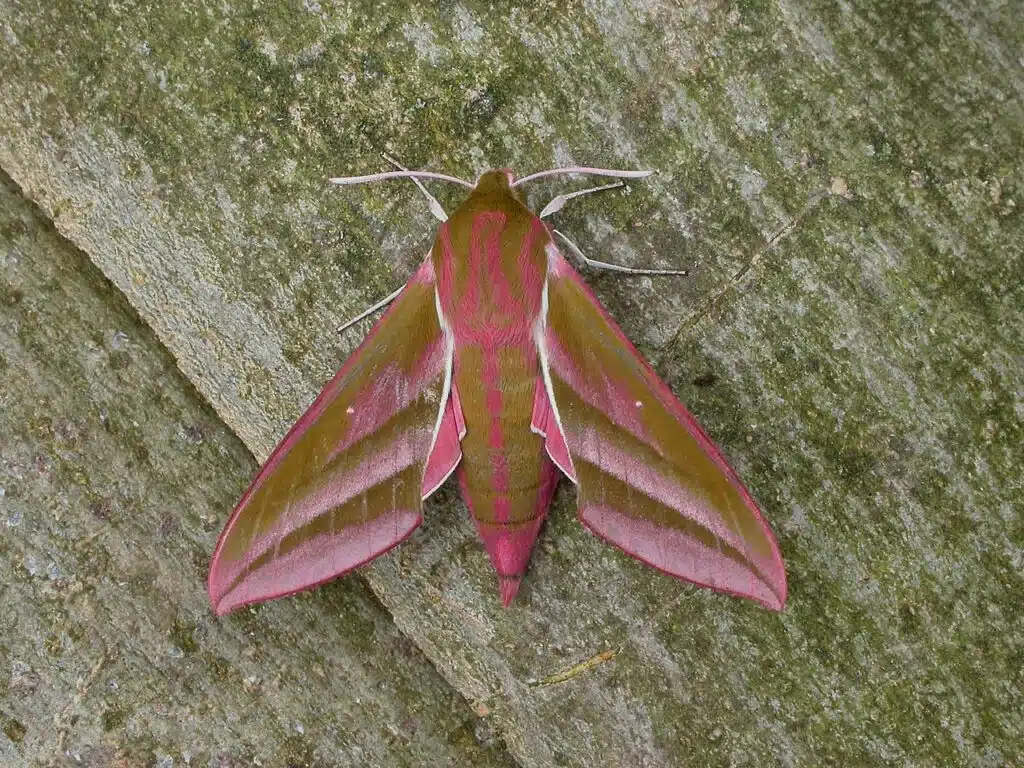
Purple or pink-purple nuances are specific to the wings yellow-brown wings of The Elephant Hawkmoth (Deilephila elpenor).
This is a species that is rarely seen due to its nocturnal feeding habits.
It prefers to feed on pollen at night and may still be seen flying during the day.
Elephant Hawkmoths live in different areas with high vegetation which include prairies and dunes.
Most Elephant Hawkmoths are spotted around woodlands.
9. Inornate Pyrausta Moth

Mostly purple wings are specific to the Inornate Pyrausta Moth (Pyrausta inornatalis). This is a species known for the pink undertone of its purple wing.
On occasion, its purple wings may also have deeper red undertones.
Inornate Pyrausta Moths are North American natives. They live East of The Rocky Mountains and are marked by a colorful appearance from their caterpillar stage.
A white, pink, or purple color may also be seen on the Inornate Pyrausta Moth Caterpillar.
10. Meadow Grasshopper
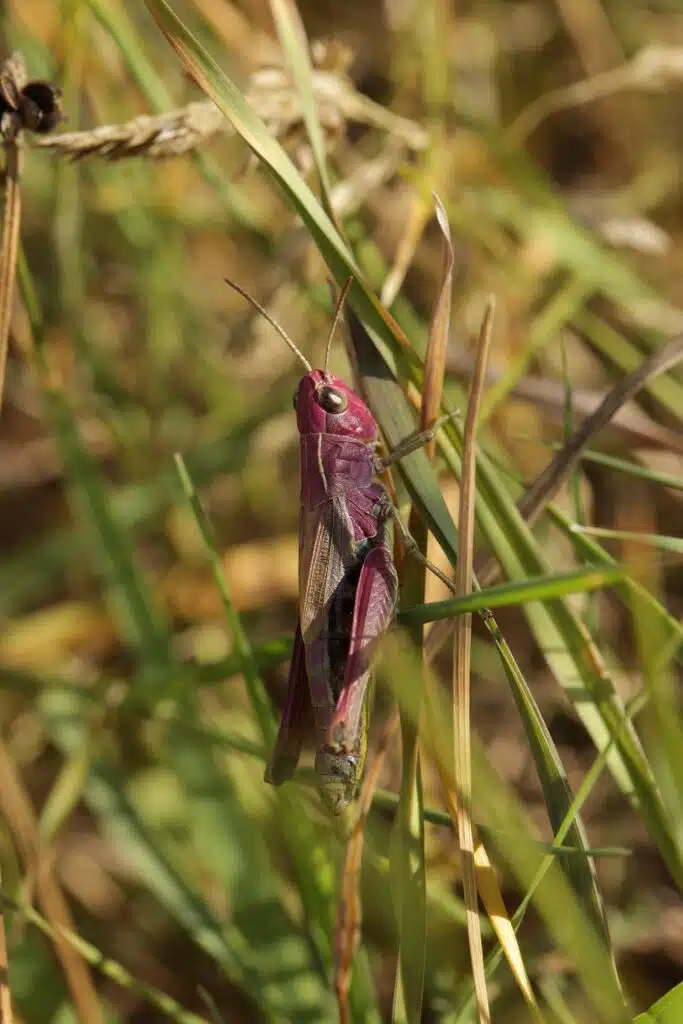
Meadow Grasshoppers (Pseudochorthippus parallelus) are some of the typical grasshoppers in Europe and East Asia.
This species is mostly seen in its common green color but a purple morph has also been associated with the species.
A brown morph and a yellow morph are also specific to The Meadow Grasshopper.
Some of the best places to see these types of colorful grasshoppers include Southern Europe Mediterranean territories around Spain, Italy, and Greece.
11. Crimson Dropwing

Crimson venation inspires the name of Crimson Dropwing dragonflies (Trithemis aurora).
It’s the male dragonfly that shows various shades of purple on its head and body. Its head is typically darker and closer to red than its body.
Female Crimson Dropwing dragonflies are mostly brown or yellow-brown and lack purple coloring.
Both males and females show transparent crimson wings, a common trait in many types of dragonflies.
Areas around water such as lake shores, ponds, and canals are ideal habitats for these dragonflies.
12. Violet Dropwing
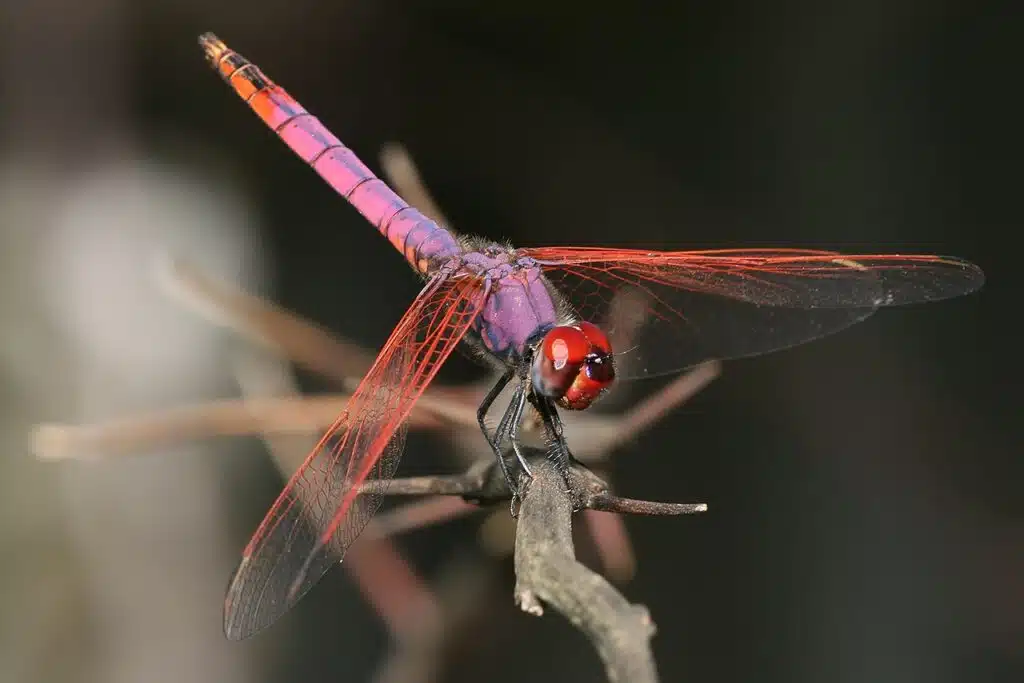
Violet Dropwings (Trithemis annulata) are another common species of dragonfly with purple coloring.
It’s only the males that show purple nuances, red or pink nuances. The females of the species have brown and green bodies, looking completely different from the males.
Both species have clear wings but males show either red or purple veins as well, a trait not seen on the transparent wings of the female which tend to show black veins,
The habitat of these dragonflies is spread around multiple continents. Violet Dropwings are European natives, African Natives, and East Asia natives.
13. Purple Tree Tarantula
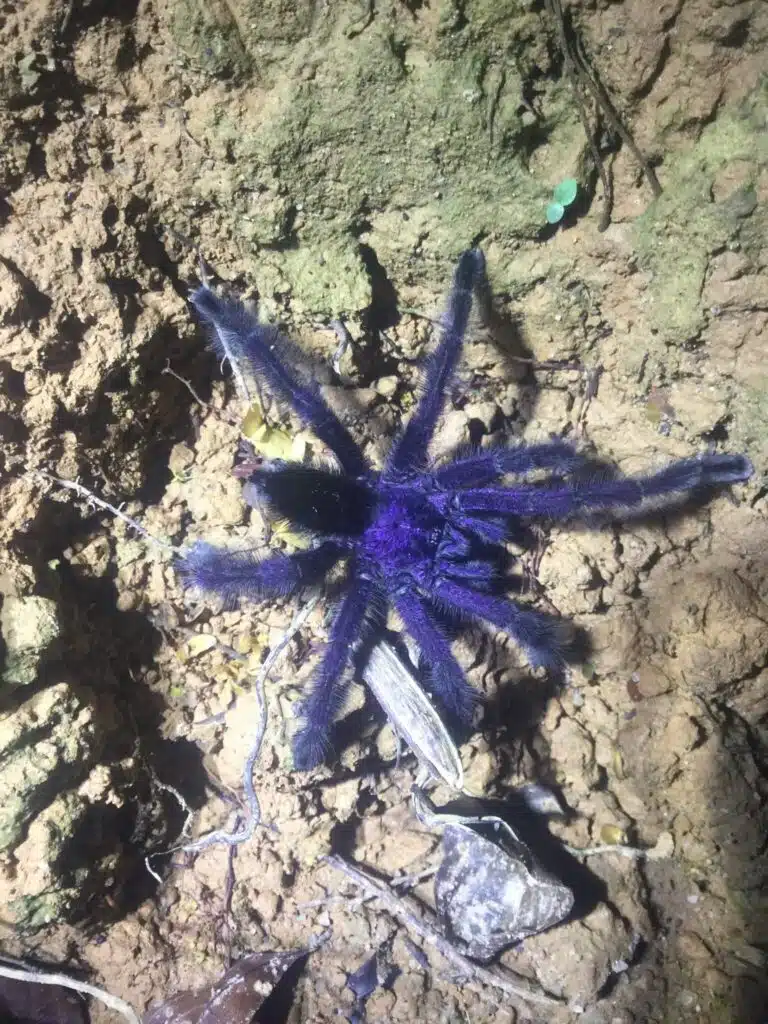
The Purple Tree Tarantula (Avicularia purpurea) is a typical docile tarantula raised in captivity.
This species is native to Ecuador where it can be seen on trees as it stands out due to its purple and black appearance.
Purple Tree Tarantulas are small, rarely reaching a size of more than 5 inches.
There’s a wide difference in the life expectancies of males and females of the species when it comes to raising this purple tarantula in captivity.
Males only survive up to a few years while females live for more than a decade.
14. Antilles Pinktoe Tarantula
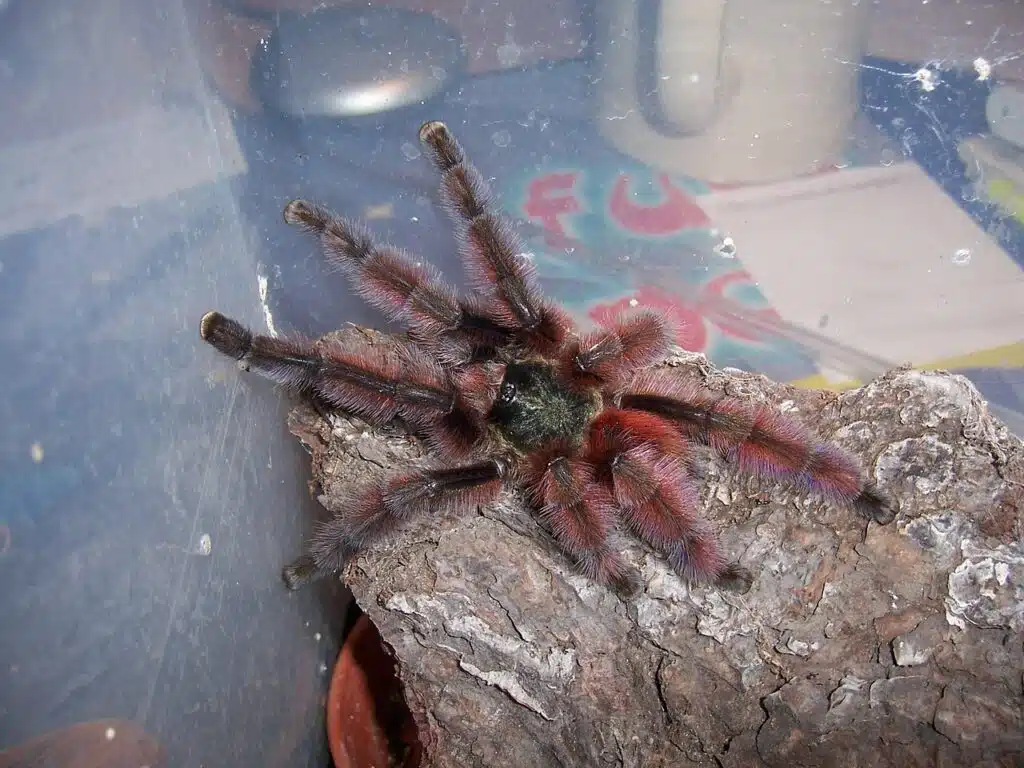
A Martinique native, The Antilles Pinktoe Tarantula (Caribena versicolor) is often seen with multiple purple hairs.
This species is initially blue. However, Antilles Pinktoe Tarantulas completely change their appearance as they mature.
Tarantulas of this species change to purple, pink, and red underbellies as they mature.
This type of colorful purple tarantula can be grown at home as it shows a peaceful character.
Raising these tarantulas in capacity is not necessarily recommended to beginners as the species requires an arboreal enclosure.
This is due to the fact they rarely venture down for food, which means insects mainly need to be placed right in front of the tarantula to be eaten.
15. Crab Spiders

Crab spiders are some of the most common types of purple bugs in The Americas.
These spiders have a colorful appearance that can adapt to their environment. Some types of crab spiders may even change colors to match the flowers or plants they live on.
Further Reading: